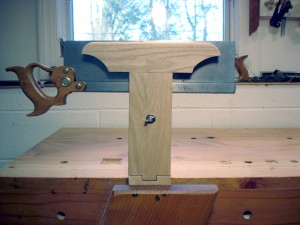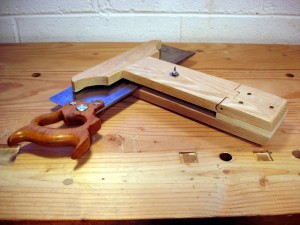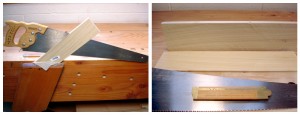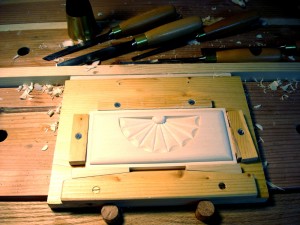 It’s been a long road. My serious woodworking interests started when I came through the door marked “small boats.” Since then, I’ve passed through many doors, each offering new interests and challenges. None included or required dovetail joinery. Until now… That’s one reason why I have been rehabilitating saws lately.
It’s been a long road. My serious woodworking interests started when I came through the door marked “small boats.” Since then, I’ve passed through many doors, each offering new interests and challenges. None included or required dovetail joinery. Until now… That’s one reason why I have been rehabilitating saws lately.
Oh yes, carving still holds my main interest, but carvings need a purpose. Not being one to construct elaborately carved furniture, 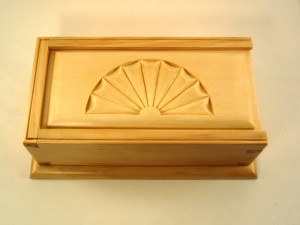 I find smaller forms more appealing. Hence, the boxes. But… dovetails? Really? (You know, small boats have neither straight lines nor square joins … nor dovetails.) OK. OK.
I find smaller forms more appealing. Hence, the boxes. But… dovetails? Really? (You know, small boats have neither straight lines nor square joins … nor dovetails.) OK. OK.
I’m learning from yet another master. Paul Sellers is in the midst of a boxmaking series at his Woodworking Masterclasses online school. While I find his classes excellent, Paul is one who always produces perfect results. So rare are his mistakes that he seldom advises how to correct them. 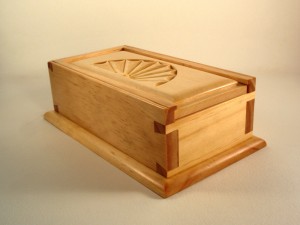 My learning comes more from (alright, mostly … maybe totally) making mistakes and learning how to fix / avoid them, and I’ve learned over the past weeks that there are elebenty-seven different ways to ruin a dovetail joint. (Nope, no pictures!)
My learning comes more from (alright, mostly … maybe totally) making mistakes and learning how to fix / avoid them, and I’ve learned over the past weeks that there are elebenty-seven different ways to ruin a dovetail joint. (Nope, no pictures!)
Without further jabbering, here’s the first dovetailed and carved box that’s worth showing:
Body: 4″ by 7 1/2″ by 2 1/4″
Base: 3/8″ larger all around
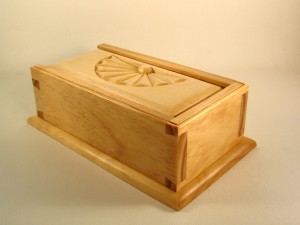
Body: New Zealand pine
Lid: Wisconsin basswood
Finish: Shellac and paste wax
It is similar to the example Sellers has been teaching, but I’ve made it my own with the carved lid. There are a couple of other variances too. Sellers cuts the groves for the lid with a tenon saw. That results in a grove that goes all the way through the end of the box and then needs tedious fitting of plugs to close the holes.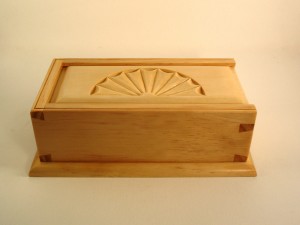 I made mine a stopped groove, like a stopped dado. This one I cut with only a chisel and knife, an experience I won’t repeat. More learning. A Record 044 just arrived from Patrick Leach in today’s mail.
I made mine a stopped groove, like a stopped dado. This one I cut with only a chisel and knife, an experience I won’t repeat. More learning. A Record 044 just arrived from Patrick Leach in today’s mail.
Sellers also cuts the rebates on the lid (for the slides) with a tenon saw. I cut mine with an ancient Stanley #78 moving fillister plane that I call Mr. Fussy. It does the job, but takes about 4 times longer to set up than just using a saw. Doh! Yet more learning.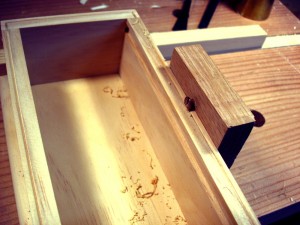
One of the last little bits of learning with this project was creating the beading on the top edge. Some time ago, I did beading on the lathe’s timbers with a scratch stock. An even simpler tool, smaller too, produces results faster. Another bit of Seller’s wisdom is a simple screw in a block of wood. The crisp edge of a single slot screw makes a great cutter. Then, hit the outside corner with a light chamfer. Fast. Easy.
The box collector in our household has already claimed this one.
